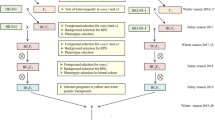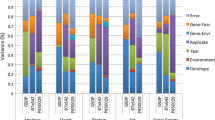Abstract
Traditionally, high amylose starch (HAS) from maize (Zea mays L.) has been mainly used as an ingredient in gum candies and as an adhesive for corrugated cardboard. Two recent advances have increased interest in the use of HAS. The first one has been the development of starch-based biodegradable thermo plastics. Second, high amylose maize is a source of resistant starch (RS), a type of starch that resists digestion. As a food additive, consumers can benefit from added RS since it will lower the glycemic index and the risk of colon cancer in accordance with recent research in food science. Normal maize has about 25% amylose starch. A maize inbred line, GEMS-0067 (Reg. no GP-550, PI 643420) possesses high amylose modifier gene(s) that, together with the recessive amylose extender (ae) gene, raises the starch amylose percentage to at least 70%. The objective of this study was to determine the gene effects, non-allelic interactions and heritability of high amylose content in maize using Bogyo’s triploid model. Nine populations were derived from a cross between H99ae, a maize inbred line with 55% amylose starch, and GEMS-0067. Data were collected from two locations in Missouri (MO) and South Dakota (SD) over 2 years (2005 and 2006). Incomplete dominance explained some of the inheritance of HAS. Maternal effects were also detected. The triploid models for MO and SD were separately established based on the corresponding data in 2005 and 2006. The additive and type 1 dominance effects in MO, and the additive, type 1 dominance, type 2 dominance, and additive × additive in SD were significantly different from zero meaning that those effects played an important role in amylose synthesis. Both broad-sense and narrow-sense heritabilities were high indicating that high amylose content could be effectively selected for in a segregating population.

Similar content being viewed by others
References
Behall K, Hallfrisch J (2002) Plasma glucose and insulin reduction after consumption of breads varying in amylose content. Eur J Clin Nutr 56:913–920. doi:10.1038/sj.ejcn.1601411
Bogyo TP, Lance RC, Chevalier P, Nilan RA (1988) Genetic models for quantitatively inherited endosperm characters. Heredity 60:61–67. doi:10.1038/hdy.1988.10
Campbell MR, Mannis SR, Port HA, Zimmerman AM, Glover DV (1999) Prediction of starch amylose content versus total grain amylose content in corn by near infrared transmittance spectroscopy. Cereal Chem 76:552–557. doi:10.1094/CCHEM.1999.76.4.552
Campbell MR, Jane JL, Pollak L, Blanco M, O’Brien A (2007) Registration of maize germplasm line GEMS-0067. J Plant Regist 1:60–61. doi:10.3198/jpr2006.10.0640crg
Fergason V (1994) High amylose and waxy corns in specialty corns by A.R. Hallauer. CRC Press, Boca Raton, pp 55–78
Fergason VL, Zuber MS (1962) Influence of environments on amylose content of maize endosperm. Crop Sci 2:209–211
Foolad MR, Jones RA (1992) Models to estimate maternally controlled genetic variation in quantitative seed characters. Theor Appl Genet 83:360–366. doi:10.1007/BF00224283
Hakizimana F, Ibrahim AMH, Langham MAC, Rudd JC, Haley SD (2004) Generation means analysis of wheat streak mosaic virus resistance in winter wheat. Euphytica 139:133–139. doi:10.1007/s10681-004-2490-y
Kao CH (2004) Multiple-interval mapping for quantitative trait loci controlling endosperm traits. Genetics 167:1987–2002. doi:10.1534/genetics.103.021642
Mather K, Jinks JH (1971) Biometrical genetics. Cornell University Press, Ithaca, pp 305–307
Mather K, Jinks JH (1977) Introduction to biometrical genetics. Cornell University Press, Ithaca, pp 36–67, 199–209
Nugent AP (2005) Health properties of resistant starch. Nutr Bull 30:27–54. doi:10.1111/j.1467-3010.2005.00481.x
Perkins JM, Jinks JL (1970) Detection and estimation of genotype-environmental, linkage and epistatic components of variation for a metrical trait. Heredity 25:157–177. doi:10.1038/hdy.1970.22
Polaske NW, Wood AL, Campbell MR, Nagan MC, Pollak LM (2005) Amylose determination of native high-amylose corn starches by differential scanning calorimetry. Starch 57:1–6. doi:10.1002/star.200400368
Pollak LM (2002) The history and success of the public-private project on germplasm enhancement of maize (GEM). Adv Agron 78:45–87. doi:10.1016/S0065-2113(02)78002-4
Pooni HS, Kumar I, Khush GS (1992) A comprehensive model for disomically inherited metrical traits expressed in triploid tissues. Heredity 69:166–174. doi:10.1038/hdy.1992.110
Wu RL, Lou XY, Ma CX, Wang XL, Larkins BA, Caselle G (2002) An improved genetic model generates high-resolution mapping of QTL for protein quality in maize endosperm. Proc Natl Acad Sci USA 99:11281–11286. doi:10.1073/pnas.112345699
Wu X, Zhao R, Wang D, Bean SR, Seib PA, Tuinara MR et al (2006) Effects of amylose, corn protein, and corn fiber contents on production of ethanol from starch-rich media. Cereal Chem 83:569–575. doi:10.1094/CC-83-0569
Younger SM (1998) Statistical research methods in the life sciences. Duxbury Press, Pacific Grove, pp 151–166
Zar JH (1974) Biostatistical analysis. Prentice Hall Inc., Englewood Cliffs, pp 130–133
Zewdie Y, Bosland PW (2003) Inheritance of seed color in Capsicum. J Hered 94:355–357. doi:10.1093/jhered/esg063
Acknowledgment
The project was funded by the Germplasm Enhancement of Maize (GEM) project of the USDA.
Author information
Authors and Affiliations
Corresponding author
Rights and permissions
About this article
Cite this article
Wu, Y., Campbell, M., Yen, Y. et al. Genetic analysis of high amylose content in maize (Zea mays L.) using a triploid endosperm model. Euphytica 166, 155–164 (2009). https://doi.org/10.1007/s10681-008-9798-y
Received:
Accepted:
Published:
Issue Date:
DOI: https://doi.org/10.1007/s10681-008-9798-y




